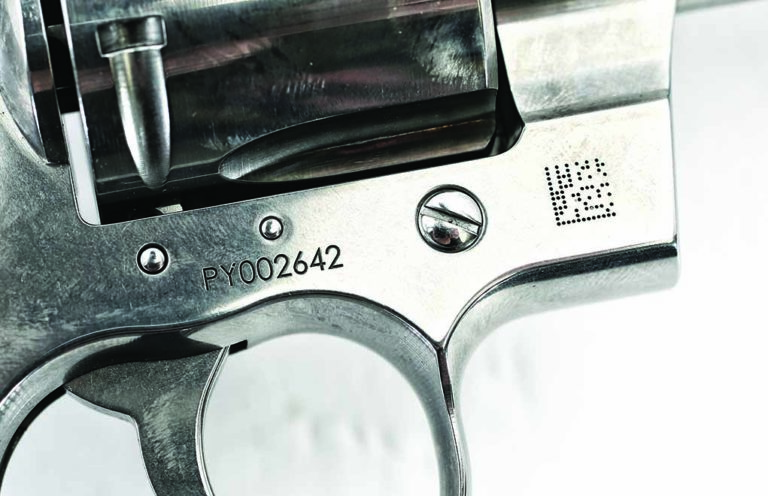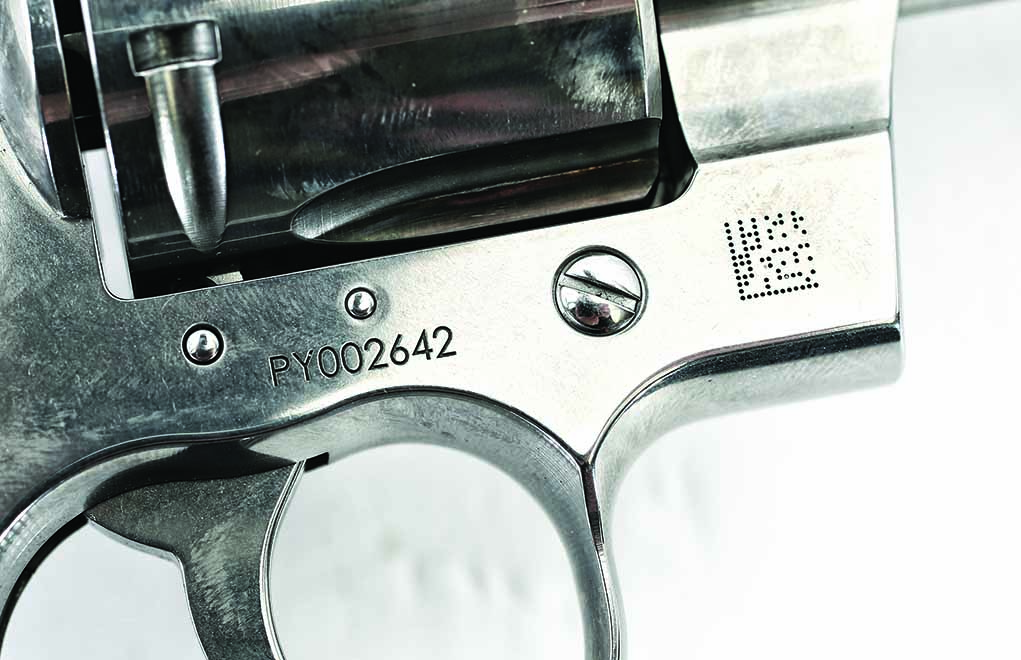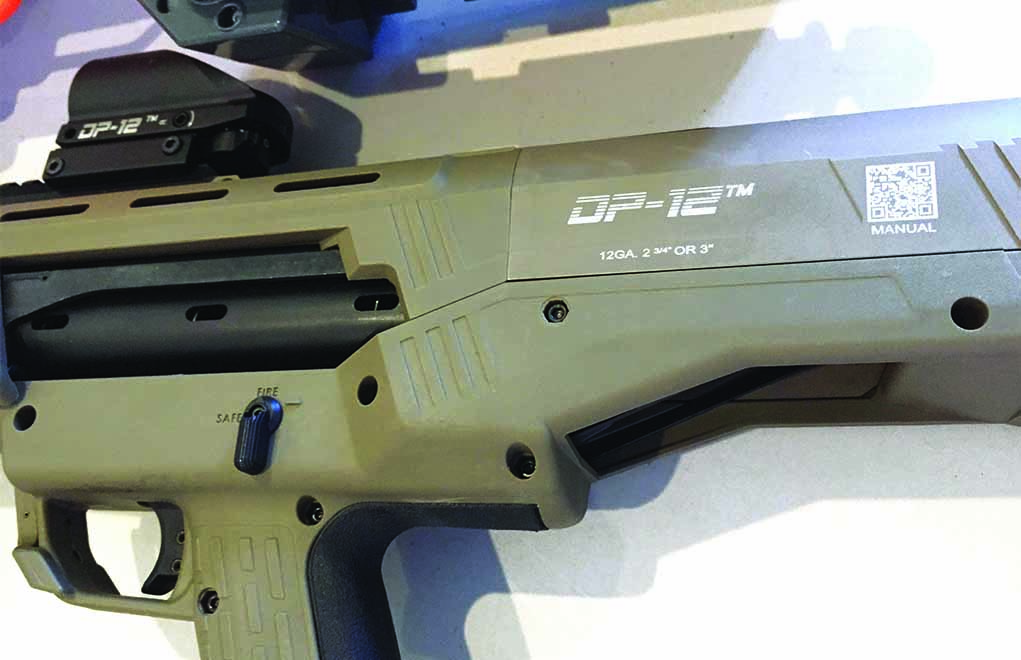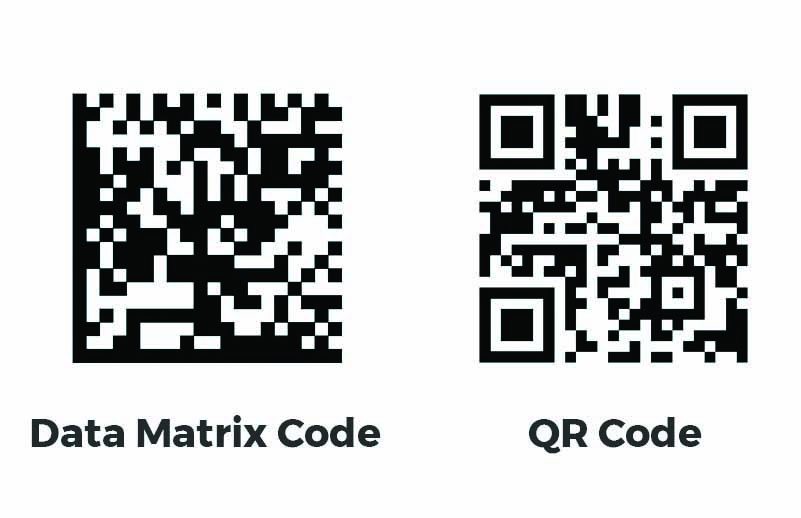
Love 'em or hate 'em, 2D data matrix codes on guns are likely to stick around.
What Are 2D Data Matrix Codes And What Purpose Do They Serve:
- The are machine-readable images used to store data, generally laser etched on to the frame of a gun.
- Manufacturers use them to track the production of a firearm as well ensure the intrigity of serial numbers.
- Information stored in each code is proprietary to each manufacturer.
- They do not take the place of the serial number and other information required by the BATF.
- No, a QR scanner won't read them … sorry.
If you’ve purchased a new firearm recently from one of several major manufacturers, you might’ve noticed a small, square pattern of dots, where before only the company’s engraved name appeared along with the gun’s model and serial number.

In an industry where the final turn of a filigree’s orientation from one model year to the next doesn’t go without notice, adding a square of asymmetrical pockmarks is sure to raise eyebrows. And to no surprise, it did, too.
As more firearms appeared on the market with these marks, discussion boards lit up, recoiling and opining endlessly on the illegible and unwelcome addition. Many views are almost comical if not misinformed, but make no mistake: Your eyes do not deceive you—something is afoot.
What is a Dot Peen Marking?
A dot peen marking is an image created using what’s known as stylus pin marking, micro pin marking, or percussion marking device to create a succession of dots that form digits, text, logos, and two-dimensional (2D) Matrix Codes. The latter being the most recent and certainly most cosmetically offensive. As a gun owner, you’ve slowly habituated to this technology without knowing it.
Several firearm companies began printing serial numbers using this technology some years ago. In recent years, lasers took the place of impact tools to create these marks. Most marks simply look like letters and numbers made from a series of dots. However, serial numbers and firearm manufacturer’s information are important and must be more than just “present and eye-readable.”

According to Bureau of Alcohol, Tobacco, Firearms, and Explosives (BATFE), firearm serial numbers must meet the following requirements:
- Must be conspicuously engraved, cast, or stamped (impressed) on the firearm frame or receiver.
- The serial number cannot duplicate the serial number appearing on any other firearm the importer previously imported.
- For firearms imported after January 30, 2002, the engraving, casting or stamping (impressing) of the serial number must be to a minimum depth of .003 inch and in a print size no smaller than 1/16 inch.
Markings must also include the name of the manufacturer, the firearm’s country of origin, model designation (if assigned), caliber or gauge, name of the importer, and the city and state of the importer. Interestingly, if a foreign manufacturer didn’t mark their firearms to this standard, the importer must do so within 15 days of their release from Customs and Border Patrol Custody.
Section 478.2 (a)(1)(i) also specifies: By engraving, casting, stamping (impressing), or otherwise conspicuously placing or causing to be engraved, cast, stamped (impressed,) or placed on the frame or receiver thereof an individual serial number. The serial number must be placed in a manner not susceptible to being readily obliterated, altered, or removed …
That’s no small amount of information, but what does that have to do with the unsightly square of dots?
The Illegible And Offensive 2D Matrix Code
At the risk of allowing the loud voices of a few speak for the majority’s opinion, most of the commenting firearm forum enthusiasts found the square of dots, the 2D Matrix Code mark, well … ugly. At a minimum, most found the mark as cosmetically welcome as Ike Turner at a NOW convention, not to mention the object of several government conspiracy theories.

Both the numbers and letters made from a line of dots, and the squares of asymmetrical dots, are designed to be read by a machine—usually with a laser inside a tooling machine or the handheld device of a factory line technician. The marks allow manufacturers to read and track a serialized part through the assembly process and into an integrated order tracking system. The parts, and ultimately the assembled firearm, can then be located anywhere on the factory premises during production and electronically logged to a specific customer when shipped.
So, if the BATFE requires this information and it must be visually legible, why do manufacturers also need an ugly mark so a machine can read it? The simple answers are efficiency and liability. In addition to production tracking, manufacturers can also ensure serial numbers are neither omitted from a series (requiring the manufacturer to account for a gun never made) or duplication (stamping two guns with the same serial number). Sorry, collectors.
Again, the 2D Matrix Code is simply a machine-readable image able to store much more information per square inch than a series of dots shaped like numbers or letters. They’re not readable by common devices such as your smartphone like Quick Response (QR) Codes and have no value to the end consumer.
However, the marks are regulated for industrial quality and consistency standards by AIM, the Association for Automatic Identification and Mobility. The exact information contained in a specific 2D Matrix Code mark is proprietary to each firearm manufacturer. So, you’d have to get the manufacturer to agree to have their machine read your mark and then share what it says.
Epidemic Or Pandemic?
Are the 2D Matrix Codes a COVID-like global pandemic for firearm aesthetics, or are they more akin a regionalized malaria epidemic. The answer is the latter. The BATFE doesn’t require manufacturers to use an electronically readable marking device, a 2D Matrix Code, nor an integrated part tracking system. Smaller manufacturers would have to reach a scale where replacing people with machines is economically sensible. In other words, if you make millions of guns a year, the investment makes sense. If you’re a small custom shop, it’s unlikely.

In silent acknowledgment of this electronically induced wart, some manufacturers managed to nest their 2D Matrix Code in less obvious locations, such as under a pistol slide. Still, most production line machines need the marks to be external and visible in order to read and track a part.
Not A QR Code
I’ve no doubt some shooters will try it, but 2D Matrix Codes aren’t designed to be scanned for information relevant to the owner or open an internet page via a scanning app on your smartphone. That’s what a QR Code does.
Visually, you can tell a 2D Matrix Code from a QR Code as the latter will have three large squares in the corners in addition to the array of dots or squares. The 2D Matrix Code will have solid lines at the left and bottom of the mark and no squares in the corners. Also, neither 2D Matrix Code nor QR Codes are the same as the more familiar bar codes that come on consumer packaging. So, for God’s sake, don’t attempt to scan your pistol at the grocery store checkout.
However, some airsoft and air rifle companies have added QR Codes to their rifles along with the serial numbers, often on a decal, as they’re not bound by ATF marking standards. In one exceptional case, the Standard Manufacturing DP-12 pump shotgun uses a QR Code on the synthetic stock to reference a website for its user’s manual. The QR Code is a clever, techie addition and not out of keeping with the shotgun’s futuristic aesthetic design of the shotgun. However, it’s not to be confused with the 2D Matrix Code, nor would it satisfy BATFE requirements.
So, love them or hate them, that’s what’s showing up on some of your new firearms. You can remove your tinfoil hats; there’s no secret chip in the gun, GPS locator, or biometric scanner—at least not yet.
Editor's Note: This article originally appeared in the October 2020 issue of Gun Digest the Magazine.
More Gun Info:
- Top 17 Affordable Precision Rifles — Bolt-Action Edition
- 13 Affordable 9mm Carbine Options
- Best 1911 Pistol Options For Concealed Carry
- .357 Magnum Revolver: Controllable Concealed Carry Options
- 9 Standout Concealed Carry Revolvers For Personal Defense
- 10 Affordable Double-Barrel Shotgun Options

Next Step: Get your FREE Printable Target Pack
Enhance your shooting precision with our 62 MOA Targets, perfect for rifles and handguns. Crafted in collaboration with Storm Tactical for accuracy and versatility.
Subscribe to the Gun Digest email newsletter and get your downloadable target pack sent straight to your inbox. Stay updated with the latest firearms info in the industry.

![Best Concealed Carry Guns In 2025 [Field Tested] Wilson Combat EDC X9S 1](https://gundigest.com/wp-content/uploads/Wilson-Combat-EDC-X9S-1-324x160.jpg)


![Best 9mm Carbine: Affordable PCCs [Tested] Ruger Carbine Shooting](https://gundigest.com/wp-content/uploads/Ruger-Carbine-Shooting-100x70.jpg)
![Best AR-15: Top Options Available Today [Field Tested] Harrington and Richardson PSA XM177E2 feature](https://gundigest.com/wp-content/uploads/Harrington-and-Richardson-PSA-XM177E2-feature-100x70.jpg)
